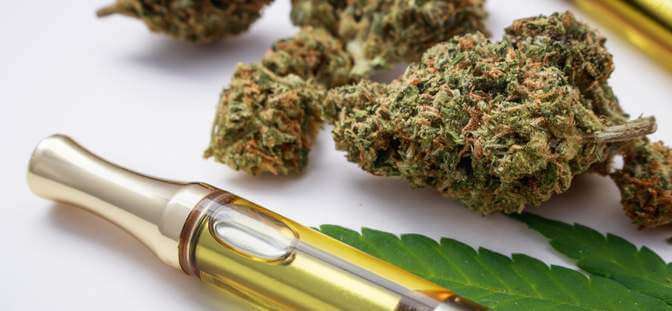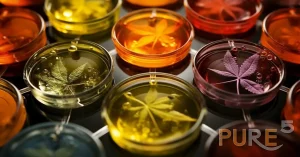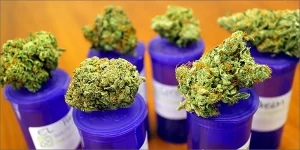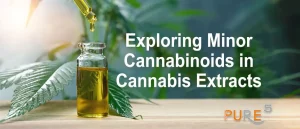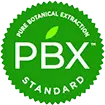What is extraction?
Cannabis extraction in terms of botanicals is removing a component from a biomass and further utilizing that component in a process.
Table of Contents
ToggleThe simplest extraction is to get a plant and chew it. Your soliva is the solvent and you get quick access to an ingredient which in case of tobacco can be nicotine or in the cannabis will be the resin. Another very simple extraction is to make a tea, although in order to isolate the ingredient you have to remove the water and that sometimes becomes a challenge.
Another challenge with the tea is if the ingredient you are looking for is in your tea and what we will discuss later in the article.
Very often in the cannabis industry the extraction means removing the resin from the biomass. Although that means only the cannabinoids. The cannabinoid is an organic substance that is a mixture of an alkaloid and a terpene, that is why they behave as both.
By nature they are resins but very well bonds to the terpene group and if we want to extract a true full spectrum oil we will need to consider extraction of the complete mixture of light oils – terpenes and thicker resins – cannabinoids.
Where is the oil?
The second part of extracting your ingredient is knowing your plant and knowing where your ingredient resides. In cannabis there are internal and external oil containers. In many of the cases the external or also called exogenetic vessels will expose the oil directly in the atmosphere and one can notice freely the aroma of the evaporated oil from the plant.
To extract the external oils, as example the trichomes, no special prep of the material is necessary such as grinding or cutting. Those oils can be directly extracted even via mechanical techniques as an example making kief out of the trichomes.
The internal or also called endogenetic oil vessels are located under the tissue and unless the tissue is disintegrated the oil remains internal and cannot be sensed.
That is why to extract those type of oils the plant needs to be chopped, crushed or milled before extraction in order to expose the internal vessels and shorten the path of the solvent to the vessel. The problem with the internal vessels are that those are mostly scattered cells surrounded with other tissues rich in lipid oils, tannins and waxes that contaminate the oil.
Extraction Methodologies
The science of extraction is very simple. Similar components extracts similar components and knowing the target group of compounds to be extracted is very important. In the cannabis flower we will be looking at quite wide group of ingredients starting from the hydrocarbons which are all mono-, sesqu-, di- terpenes, saturated and non saturated alcohols, saturated, unsaturated and aromatic ketones, saturated and unsaturated aldehydes and ending with some saturated and unsaturated acids.
In brief the terpenes, ketones, aldehydes and acids are building the composition of the full spectrum cannabis oil.
As one can imagine to extract the combination of those a solvent needs to be properly selected. The botanical ingredient diagram below shows those target ingredients in red in the entire range of plant ingredients and various solvents that can extract those.
There are 3 main groups of solvents by the target group of plant components. There are oils called oil solubles, the flavones, alcohols and acids are known as alcohol soluble and tannins, minerals and pectins that are known as water soluble. That puts our solvents in 3 major groups mainly differentiated by their polarity.
So how the polarity works. The solvents are complex organic chemicals that consist of molecules. The molecules have various shapes and special configurations which depend on their bonding groups may be more symmetrical or disproportional. In general if the distribution of the electrons between bonded atoms is even the molecule is nonpolar or if it is uneven is polar.
Polarity is a description of how different the electrical poles of a molecule are, therefore the electrical potential of the molecule is different. So polarity forms a scale depending on the electronegativity of each bonded atom in the molecule.
For example the molecule of water has a large oxygen atom with atomic weight of 16 and two small hydrogen atoms with a weight of 1 and the water will have extremely polar performance as a solvent. As we see it from the chart the water extracts polar plant ingredients located on the right side of the table. Then a hydrocarbon will have a very small inert and symmetrical bond between carbon and hydrogen and it is a nonpolar molecule that will extract the ingredients on the left side also called oils and oil soluble.
Usually those nonpolar ingredients are very volatile and have a boiling point below 20C. Also unfortunately due that volatility the majority of those chemicals are extremely flammable. So when used as a solvent strict precautions of safety has to be considered. The next group of solvents are the alcohols and their molecule is much more polar but still their boiling point is below 100C.
As we have discussed above the electrical potential of the molecule of a solvent allows that solvent to extract different parts of the botanical ingredient table. The electrical potential of the molecule is easily characterized and measured by the dielectric constant of the chemical.
In order to simplify the solubility of each solvent it is enough to know its dielectric constant and then we will have a pretty good idea what botanical ingredients it will dissolve.
For example, the dielectric constant of ethanol is 24, water 80, hexane 2, hydrocarbons 7.
Fig. 1
Since we now know everything we need to know about the solvents, let’s discuss the application of those and one more very important parameter – the recovery. Since the simplest extraction was making tea, the separation of the ingredients in its pure form is also very important. Once the extracted ingredients are mixed with the solvent the easiest way is to separate the solvent by evaporating it.
Although evaporating the solvent very often will evaporate most of our target ingredients all together and first we will have low yield of partial extract and second a contaminated solvent. What happens very often with ethanol since the ethanol evaporation point is around 80C and the oils we target start evaporating at around that temperature to around 195C, so we’ll always have a problem with yield, contamination and solvent residue in the final product.
That is why gas solvents as CO2 are preferred instead of liquid solvents as ethanol and highly desired in order to provide much cleaner extraction. Although a solvent extract in contact with the plant material when in it is a liquid phase. That is why a class of extraction techniques called liquified gas extraction was developed.
The idea is to pressurize or chill the gas solvent to a point it becomes liquid and start to behave as a solvent, then when the mixture of oil and solvent leaves the plant it is easier to separate by quickly returning the gas in its natural state and the extract is drained purely without a solvent residue. That is why very often the CO2 extraction is called solventless.
The problem with the CO2 is that its boiling point is below -100C and it becomes liquid at -56C then it becomes more efficient solvent when its aggregate condition is beyond liquid at 31C. That condition is called supercritical fluid, when the CO2 behaves as liquid and solid at the same time.
That requires extreme pressure during the process in order to enter that supercritical phase. The extra energy and hardware usually makes the systems built with CO2 very expensive. In order to simplify the extraction systems a gas with better thermodynamics needs to be selected.
As example the hydrocarbon R134a has boiling at -30C and being liquid at 25C is a very sweet spot for an extraction efficiency. The R134a has the selectivity of a hydrocarbon being non flammable, extraction behaviour on a solventless process as CO2 and overcomes the disadvantages of ethanol by being separated very easily and not extracting the extra components from the right side of the chart commonly called waxes and lipids, etc.
Type of extraction concentrates
There are many types of concentrates used in making infused products and every one of them is unique to the method of extraction. In its early days the cannabis industry started with the so called rick Simpson oil later known as ethanol crude, then evolved to distillates, isolates, resins and terpenes. But even 2 crudes extracted from 2 extraction solvents are not alike. We already explained why since the solvent will draw different plant ingredients. It is the same with distillates, distillates, isolates, resins and terpenes.
Dabs
Dabs are concentrated doses of cannabis that are made by extracting THC and other cannabinoids using a solvent like butane or carbon dioxide, resulting in sticky oils. The dabs are made mostly from the acidic cannabinoids while maintaining the wac content high. Depending on their consistency, these marijuana concentrates are also commonly referred to as wax, shatter, budder, and butane hash oil. Marijuana wax and other dabs are typically heated on a hot surface, usually a nail, and then inhaled through a dab rig. Smoking dabs as a method of consumption has been around for at least a decade, but the advent of more advanced extraction methods have led to a flood of cannabis concentrates that have boosted dabbing’s popularity.
Vapes
Vaping devices, also known as e-cigarettes, e-vaporizers, or electronic vapour delivery systems, are battery-operated devices that people use to inhale an aerosol, which typically contain cannabis oil, terpene oils, flavorings, and other chemicals. They can resemble traditional tobacco cigarettes (cig-a-likes), cigars, or pipes, or even everyday items like pens or USB memory sticks. Other devices, such as those with refillable tanks, may look different. Regardless of their design and appearance, these devices generally operate in a similar manner and are made of similar components. More than 460 different e-cigarette brands are currently on the market.
Tinctures
Tinctures are concentrated herbal extracts made by soaking the bark, berries, leaves (dried or fresh), or roots from one or more plants in alcohol or vinegar. The alcohol or vinegar pulls out the active ingredients in the plant parts, concentrating them as a liquid. There’s some research and anecdotal reports that suggest some plants have medicinal properties and health benefits. Tinctures have been around for millennia and are a key component of traditional herbal medicine.
Hash
Hash comes from Hashish and is nothing more than the cannabis trichomes separated mechanically from a plant, most of the times pressed together to make a brick. The trichomes are the richest part of cannabis in plants, they are filled with the cannabinoids. The trichomes contain the most natural cannabis oil that has a wide variety of ingredients. Extracted hash is primarily used for dabbing since the oil will maintain the original plant terpenes and waxes and will bring the most natural experience.
Rosin
Rosin refers to an extraction process that utilizes a combination of heat and pressure to nearly instantaneously squeeze resinous sap from your initial starting material. The term “rosin” originated as a method of making a product used to create friction with violin bows.Depending on how it’s extracted, rosin (especially flower rosin) can be considered full-spectrum. Hash rosin, however, is more commonly a select-spectrum extract.
Rosin vs. resin
Broadly speaking, resin refers to a viscous substance derived from plants. Live resin can be made from cannabis concentrate by taking fresh cannabis and freezing it to subcritical temperatures both before and during the extraction process. This allows the live resin to retain the plant’s terpene profile, whereas with rosin, certain extraction processes may result in a loss of some terpenes. Another option of extracting high terpene resins is by using solvent hydrocarbon or R134a extraction where the terpenes are pulled from the plant with around 20-30% concentration and the cannabinoids with around 60-70%.
Decarboxylation
By definition, decarboxylation is a chemical reaction that removes a carboxyl group and releases carbon dioxide. Decarboxylation occurs when cannabis is exposed to heat, light, cofactors, or solvents, all of which can be manipulated within your own kitchen. The bigger question is when do we decarboxylate – before or after extraction?
When you decarb you change the structure of the molecule. The acid form converts to a light alcohol form therefore the polarity of the molecule and the dielectric constant on the ingredient changes. Usually it goes down which also lowers the boiling points. Therefore that conversion will allow some of the non polar solvents to extract this molecule faster and easier. Below is a table showing various times on decarboxylation applicable to plant and extracted oil.
Fig. 2
When decarboxylate oil the process is difficult to control since the rate depends on the volume, temperature and the temperature exchange in the vessel. Very often due the proper temperature setup the loss is too high as the usual efficiency in oil decarbing is 88%. PURE5™ has a low temperature THC remediation and decarbing solution with 90% and higher efficiency.
Conclusion
Making your extraction strain specific requires a full understanding of the flower, the solvent and the process involved. Using a good grown strain extracted with a nonpolar solvent preferably by liquified gas at room temperature is the most pristine way of extracting it.
In the last 6 years, PURE5™ Cannabis extraction equipment produced the best strain specific oils extracted with their proprietary developed non flammable and most safely selected modified hydrocarbon method utilizing R134a removing the full spectrum of terpenes and cannabinoids in their acid and converted forms.
The process known as the PBX (Pure Botanical Extraction) achieved large customer recognition in vapes, tinctures, dabs and isolated terpene markets.
# # #
Contact information:
George Stantchev, PhD
+1 (602) 992-0744
pure5extraction.com

